In this article, we will share the ranking of 193 countries in the world based on their GDP (Gross Domestic Product) during 2019. We have used the publicly available data from IMF (International Monetary Fund) to rank the countries. We have also provided an analysis based on whether the countries are developed or developing. IMF classifies these countries as ‘advanced economies’ and ’emerging market and developing economies’ respectively (Please see the notes at the bottom). Of the 193 countries, 39 countries classified as advanced economies and the remaining are classified as emerging market and developing economies.
This article is part of a series of articles ranking the countries in the world based on their GDP related indicators. In our other articles, we have provided world GDP per capita rankings , world GDP PPP (purchasing power parity) rankings , world GDP PPP per capita rankings , and world real GDP growth rankings.
In this article, we will first provide the charts for the nominal GDP from 1980 to 2020 for the whole world, the advanced economies, and the developing economies. Then, we will present GDP ranking of the countries grouped by regions. Then, we will provide GDP ranking of all the countries in the world, the developed world, and the developing world.
World Total GDP 1980-2020
The world total nominal GDP reached $84.9 trillion during 2018. The total GDP of the developed countries (aka advanced economies) was $51.2 trillion during 2018. The total GDP of the developing countries (aka emerging market and developing economies) was $33.7 trillion during 2018.
IMF estimates the world GDP to reach $86.6 trillion during 2019. IMF estimates that advanced economies total GDP would reach $51.7 trillion and developing economies total GDP would reach $34.9 trillion during 2019.
The world GDP has nearly doubled during the 15-year period from 2004 to 2019. During the same period, the advanced economies GDP has increased 1.5-times, whereas the developing economies GDP has increased 3.7-times.
The chart below provides the advanced vs developing economies GDP data from 1980 to 2020.
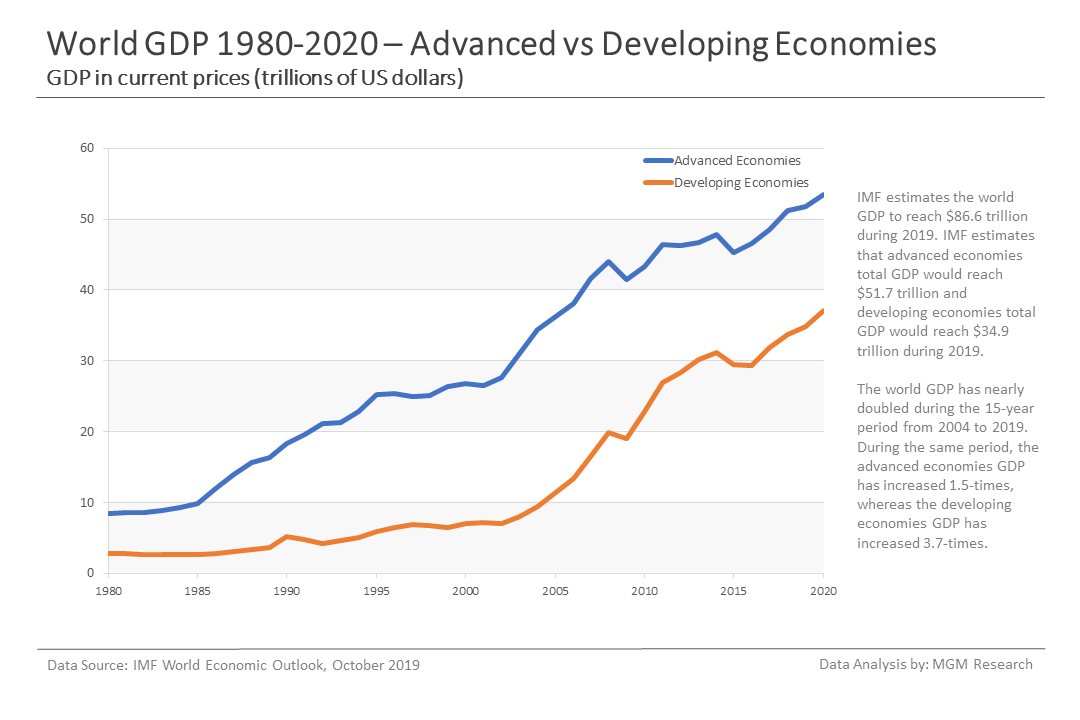
World GDP Share 1980-2020
The share of the developed countries in the world total GDP was 60.3% during 2018. The share of the developing countries in the world total GDP was 39.7% during 2018.
IMF estimates the share of the advanced economies in the world total GDP to be 59.8% during 2019. The share of the developing economies is estimated to be 40.2% during 2019.
The share of the developing economies in the world total GDP has more than doubled during the past two decades. Twenty years back, during 1999, the share of the developing countries in the world total GDP was 19.7%.
The chart below provides the advanced vs developing economies GDP share data from 1980 to 2020.
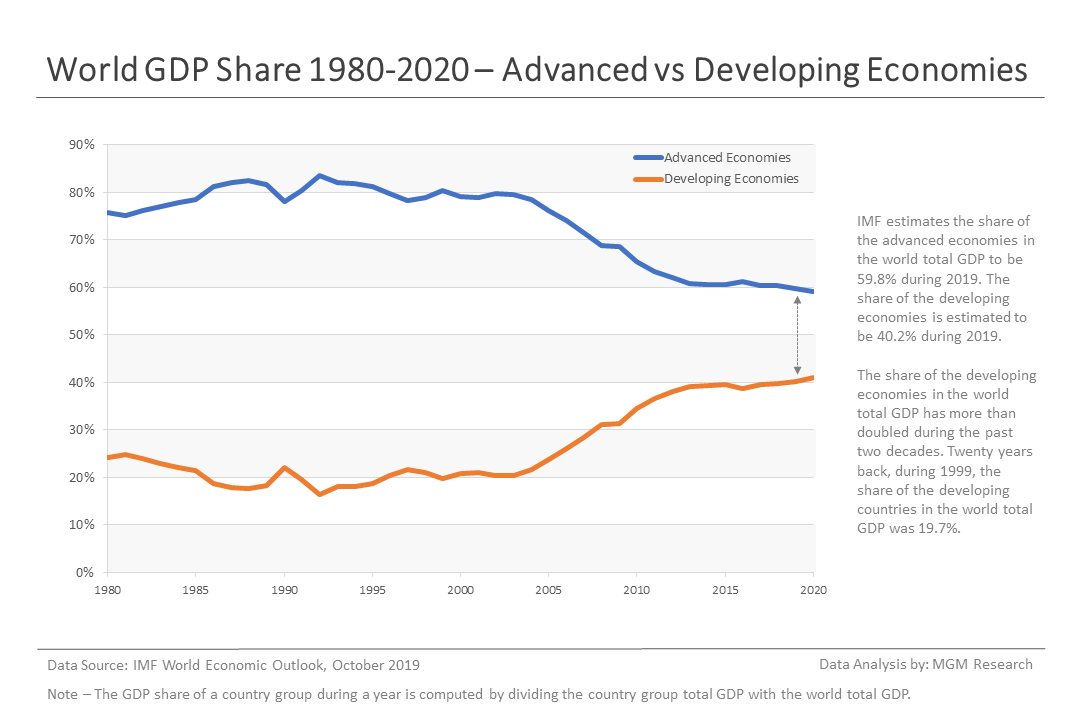
Americas GDP Ranking by Region
United States is not only the largest economy of the Americas, but also the whole world. Canada, Brazil, Mexico, and Argentina are the second, third, fourth, and fifth largest economies respectively in the western hemisphere.
US GDP is more than three-times the total GDP of all the countries in the western hemisphere.
IMF GDP estimate for 2019 for the different countries in the four regions of Americas is as follows.
North America - United States $21,439 bn, Canada $1,731 bn
Central America - Mexico $1,274 bn, Guatemala $81 bn, Panama $69 bn, Costa Rica $61 bn, El Salvador $27 bn, Honduras $24 bn, Nicaragua $13 bn, Belize $2 bn
South America - Brazil $1,847 bn, Argentina $445 bn, Colombia $328 bn, Chile $294 bn, Peru $229 bn, Ecuador $108 bn, Venezuela $70 bn, Uruguay $60 bn, Bolivia $42 bn, Paraguay $41 bn, Guyana $4 bn, Suriname $4 bn
Caribbean - Puerto Rico $100 bn, Dominican Republic $89 bn, Trinidad and Tobago $23 bn, Jamaica $16 bn, The Bahamas $13 bn, Haiti $9 bn, Barbados $5 bn, Aruba $3 bn, Saint Lucia $2 bn, Antigua and Barbuda $2 bn, Grenada $1 bn, Saint Kitts and Nevis $1 bn, Saint Vincent $0.9 bn, Dominica $0.6 bn
The chart below provides the IMF GDP estimate for 2019 for the 36 countries in Americas.
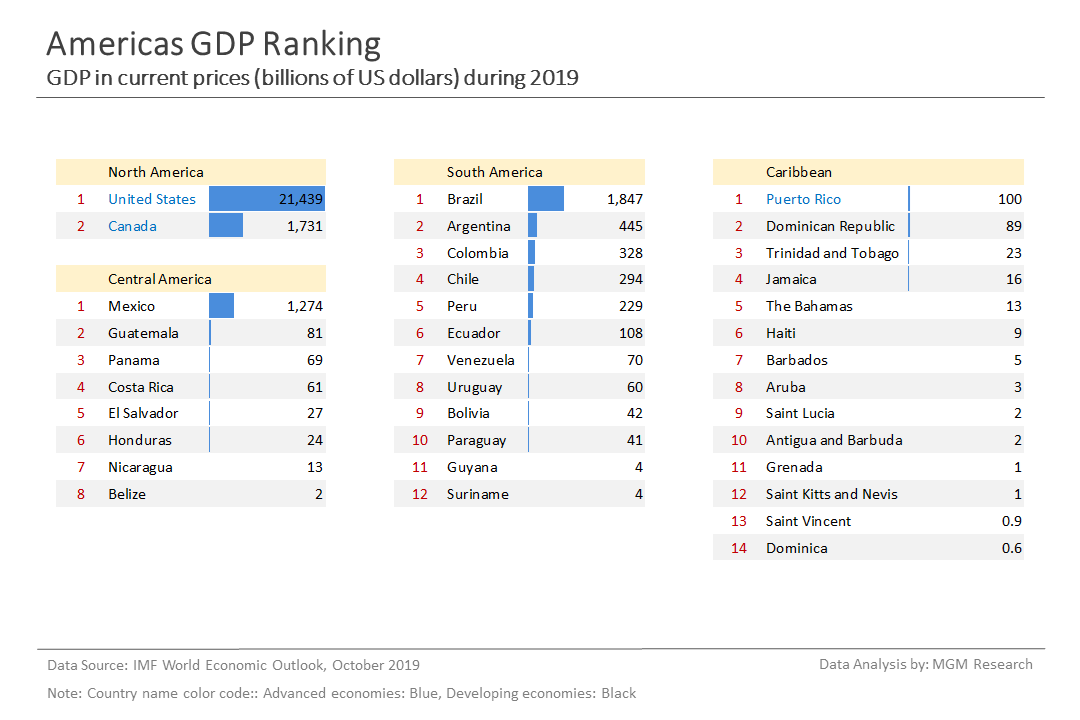
Europe GDP Ranking by Region
Germany is the largest economy of Europe. The UK, France, Italy, and Russia are the second, third, fourth, and fifth largest economies respectively in Europe. IMF GDP estimate for 2019 for the different countries in Western and Eastern Europe is as follows.
Western Europe - Germany $3,863 bn, United Kingdom $2,744 bn, France $2,707 bn, Italy $1,989 bn, Spain $1,398 bn, Netherlands $902 bn, Switzerland $715 bn, Sweden $529 bn, Belgium $518 bn, Austria $448 bn, Norway $418 bn, Ireland $385 bn, Denmark $347 bn, Finland $270 bn, Portugal $236 bn, Greece $214 bn, Luxembourg $69 bn, Cyprus $24 bn, Iceland $24 bn, Malta $15 bn, San Marino $2 bn
Eastern Europe (EU Members) - Poland $566 bn, Czech Republic $247 bn, Romania $244 bn, Hungary $170 bn, Slovak Republic $107 bn, Bulgaria $66 bn, Croatia $61 bn, Slovenia $54 bn, Lithuania $54 bn, Latvia $35 bn, Estonia $31 bn
Eastern Europe (Non-EU Countries) - Russia $1,638 bn, Ukraine $150 bn, Belarus $63 bn, Serbia $52 bn, Bosnia and Herzegovina $20 bn, Albania $15 bn, North Macedonia $13 bn, Moldova $12 bn, Kosovo $8 bn, Montenegro $5 bn
The chart below provides the IMF GDP estimate for 2019 for the 42 countries in Europe.

Asia and Pacific GDP Ranking by Region
China is the largest economy in Asia and Pacific. Japan, India, South Korea, and Australia are the second, third, fourth, and fifth largest economies respectively in Asia and Pacific. IMF GDP estimate for 2019 for the different countries in the five regions of Asia and Pacific is as follows.
East Asia - China $14,140 bn, Japan $5,154 bn, South Korea $1,630 bn, Taiwan $586 bn, Hong Kong SAR China $373 bn, Macao SAR China $55 bn, Mongolia $14 bn
South Asia - India $2,936 bn, Bangladesh $317 bn, Pakistan $284 bn, Sri Lanka $87 bn, Nepal $30 bn, Maldives $6 bn, Bhutan $3 bn
Southeast Asia - Indonesia $1,112 bn, Thailand $529 bn, Malaysia $365 bn, Singapore $363 bn, Philippines $357 bn, Vietnam $262 bn, Myanmar $66 bn, Cambodia $27 bn, Laos $19 bn, Brunei Darussalam $12 bn, Timor-Leste $3 bn
Australia and New Zealand - Australia $1,376 bn, New Zealand $205 bn
Pacific Islands - Papua New Guinea $24 bn, Fiji $6 bn, Solomon Islands $1 bn, Vanuatu $1 bn, Samoa $0.9 bn, Tonga $0.5 bn, Micronesia $0.4 bn, Palau $0.3 bn, Marshall Islands $0.2 bn, Kiribati $0.2 bn, Nauru $0.1 bn, Tuvalu $0.04 bn
The chart below provides the IMF GDP estimate for 2019 for the 39 countries in Asia and Pacific.

Middle East and Central Asia GDP Ranking by Region
Saudi Arabia is the largest economy of Middle East. Turkey is the largest economy of Central Asia and the Caucasus region. IMF GDP estimate for 2019 for the different countries in Middle East and Central Asia is as follows.
Middle East - Saudi Arabia $779 bn, Iran $459 bn, United Arab Emirates $406 bn, Israel $388 bn, Iraq $224 bn, Qatar $192 bn, Kuwait $138 bn, Oman $77 bn, Lebanon $59 bn, Jordan $44 bn, Bahrain $38 bn, Yemen $30 bn
Central Asia and the Caucasus - Turkey $744 bn, Kazakhstan $170 bn, Uzbekistan $60 bn, Azerbaijan $47 bn, Turkmenistan $47 bn, Afghanistan $19 bn, Georgia $16 bn, Armenia $13 bn, Kyrgyz Republic $8 bn, Tajikistan $8 bn
The chart below provides the IMF GDP estimate for 2019 for the 23 countries in Middle East and Central Asia.
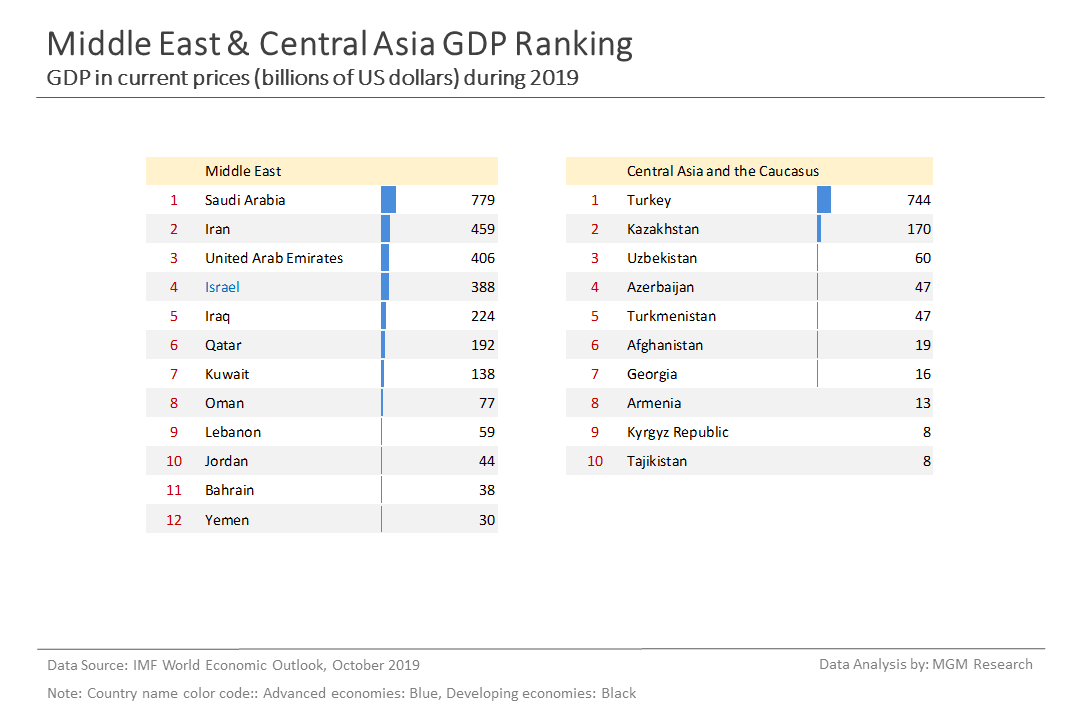
Africa GDP Ranking by Region
Nigeria is the largest economy of Africa. South Africa ranks second.
The total GDP of the 54 countries in Africa is $2.4 trillion. If they all were one country, they would rank eighth in the world GDP ranking.
IMF GDP estimate for 2019 for the different countries in Africa is as follows.
North Africa - Egypt $302 bn, Algeria $173 bn, Morocco $119 bn, Tunisia $39 bn, Libya $33 bn
Sub-Saharan Africa - Nigeria $447 bn, South Africa $359 bn, Kenya $99 bn, Angola $92 bn, Ethiopia $91 bn, Ghana $67 bn, Tanzania $62 bn, DR Congo $49 bn, Côte d’Ivoire $44 bn, Cameroon $39 bn, Sudan $31 bn, Uganda $31 bn, Zambia $24 bn, Senegal $24 bn, Botswana $19 bn, Mali $18 bn, Gabon $17 bn, Mozambique $15 bn, Burkina Faso $15 bn, Mauritius $14 bn, Benin $14 bn, Namibia $14 bn, Guinea $13 bn, Zimbabwe $13 bn, Madagascar $13 bn, Equatorial Guinea $12 bn, Congo $12 bn, Chad $11 bn, Rwanda $10 bn, Niger $9 bn, Malawi $8 bn, Mauritania $6 bn, Togo $6 bn, Somalia $5 bn, Eswatini $5 bn, Sierra Leone $4 bn, South Sudan $4 bn, Burundi $4 bn, Liberia $3 bn, Djibouti $3 bn, Lesotho $3 bn, Central African Republic $2 bn, Eritrea $2 bn, Cabo Verde $2 bn, The Gambia $2 bn, Seychelles $2 bn, Guinea-Bissau $1 bn, Comoros $1 bn, São Tomé and Príncipe $0.4 bn
The chart below provides the IMF GDP estimate for 2019 for the 54 countries in Africa.
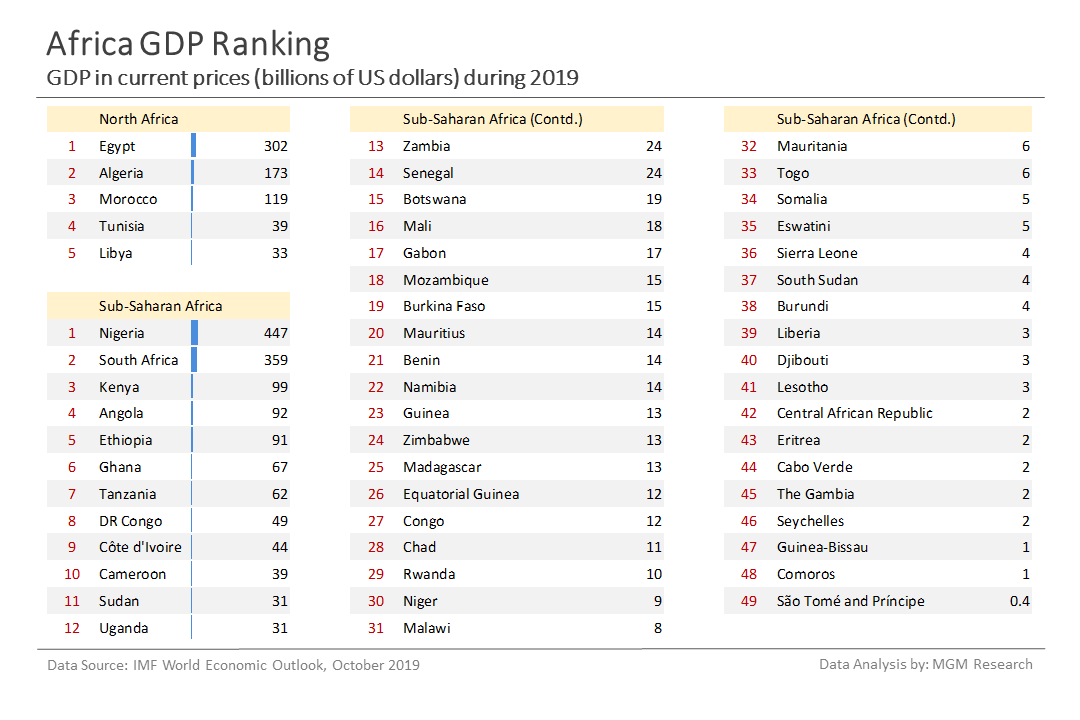
World GDP Ranking
The United States leads the world GDP rankings with 24.8% share of the world total GDP during 2019. The United States is followed by China, Japan, Germany, and India with GDP share of 16.3%, 6.0%, 4.5%, and 3.4% respectively of the world total GDP during 2019. The top-5 countries by GDP account for 54.9% of the world total GDP. The top-10 and top-20 countries account for 67.6% and 81.0% of the world total GDP respectively.
Here are the GDP rankings of the world top-10 economies along with their GDP in 2019.
- The United States is ranked 1 with a GDP of $21.4 trillion.
- China is ranked 2 with a GDP of $14.1 trillion.
- Japan is ranked 3 with a GDP of $5.2 trillion.
- Germany is ranked 4 with a GDP of $3.9 trillion.
- India is ranked 5 with a GDP of $2.9 trillion.
- The United Kingdom is ranked 6 with a GDP of $2.7 trillion.
- France is ranked 7 with a GDP of $2.7 trillion.
- Italy is ranked 8 with a GDP of $2.0 trillion.
- Brazil is ranked 9 with a GDP of $1.8 trillion.
- Canada is ranked 10 with a GDP of $1.7 trillion.
The charts below list all the 193 countries as per their GDP rank.
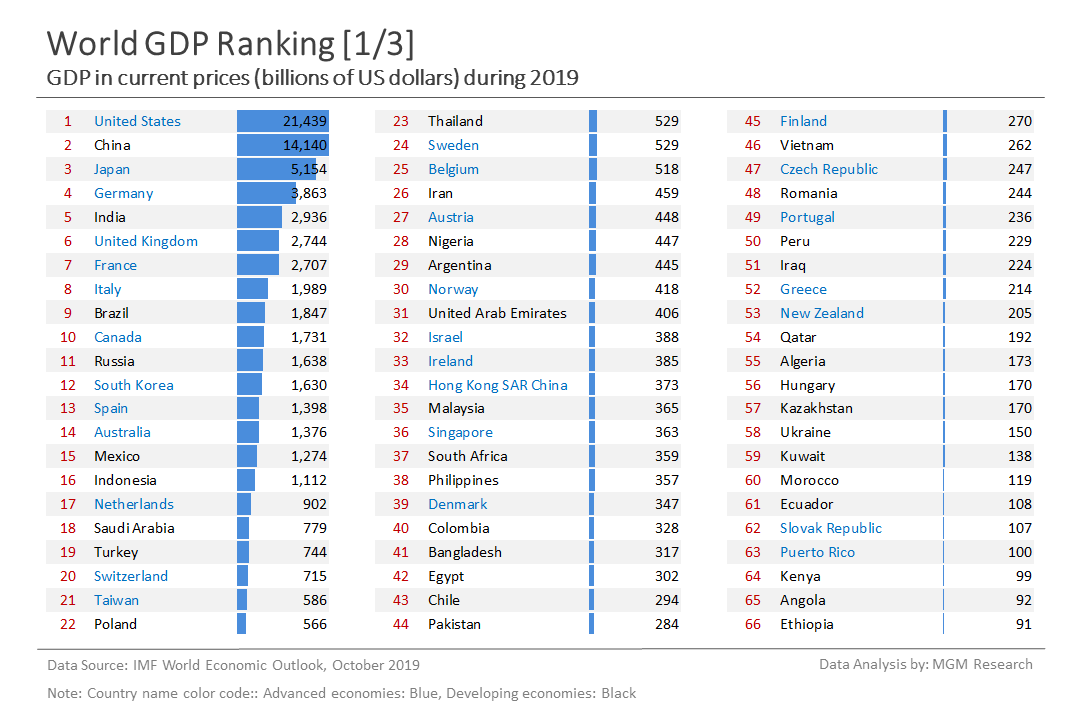
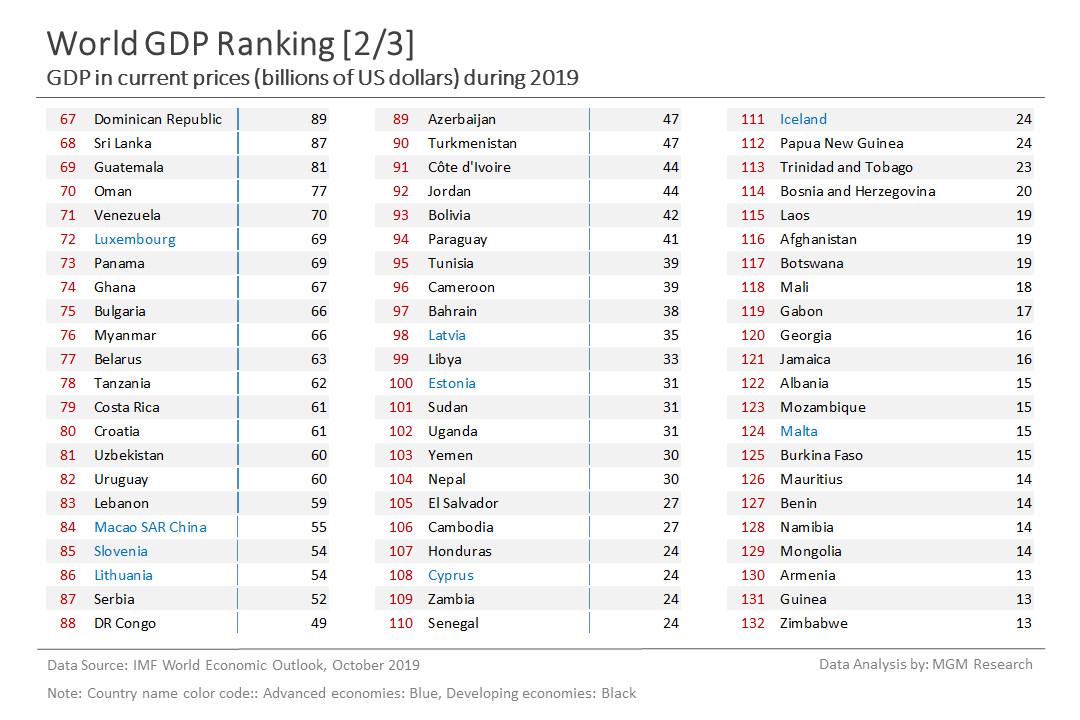
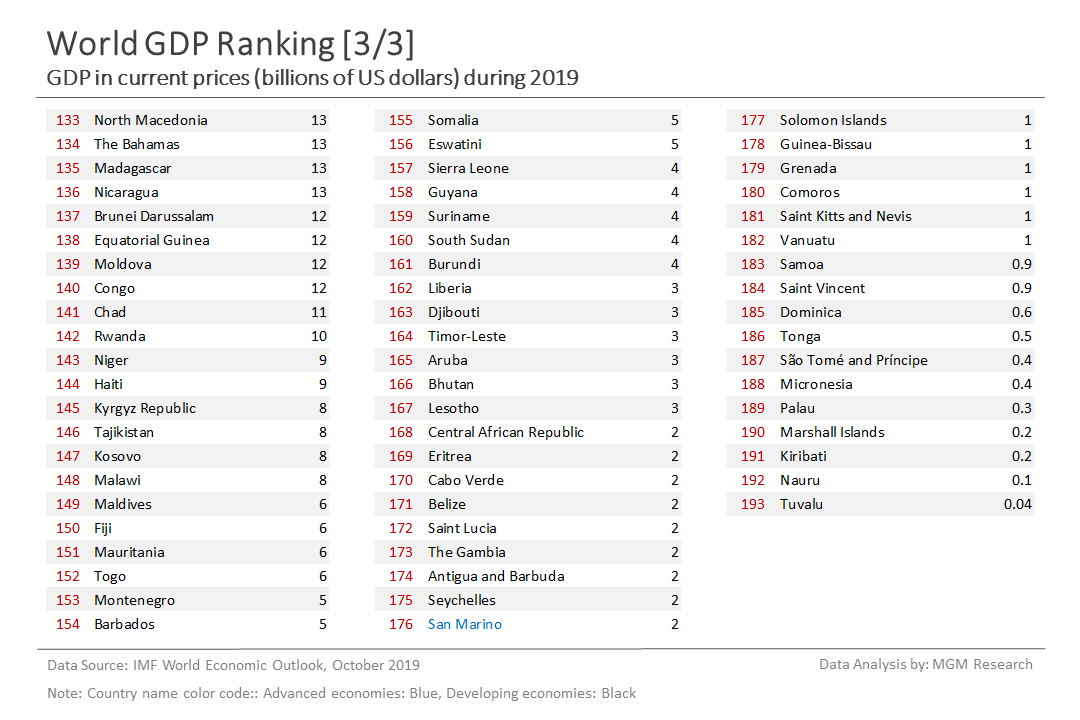
World GDP Ranking – Developed countries
The United States leads the developed world GDP rankings with 41.4% share of the developed world total GDP during 2019. The United States is followed by Japan, Germany, the United Kingdom, and France with GDP share of 10.0%, 7.5%, 5.3%, and 5.2% respectively of the developed world total GDP during 2019. The top-5 countries by GDP account for 69.4% of the developed world total GDP. The top-10 and top-20 countries account for 85.1% and 95.3% of the developed world total GDP respectively. The chart below lists the advanced economies only as per their GDP rank. The top-7 countries in this list are the G7 (Group of Seven) nations.
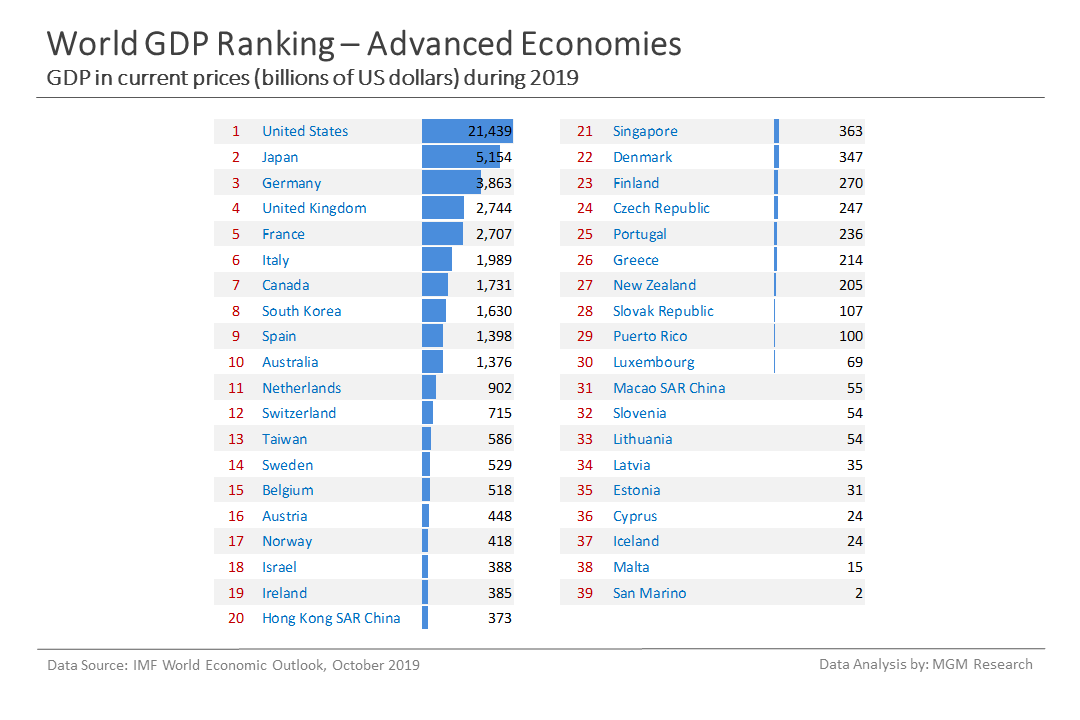
World GDP Ranking – Developing countries
China leads the developing world GDP rankings with 40.6% share of the developing world total GDP during 2019. China is followed by India, Brazil, Russia, and Mexico with GDP share of 8.4%, 5.3%, 4.7%, and 3.7% respectively of the developing world total GDP during 2019. The top-5 countries by GDP account for 62.6% of the developing world total GDP. The top-10 and top-20 countries account for 73.3% and 84.2% of the developing world total GDP respectively. The charts below list the emerging market and developing economies as per their GDP rank. The top-4 countries in this list are the BRIC countries.
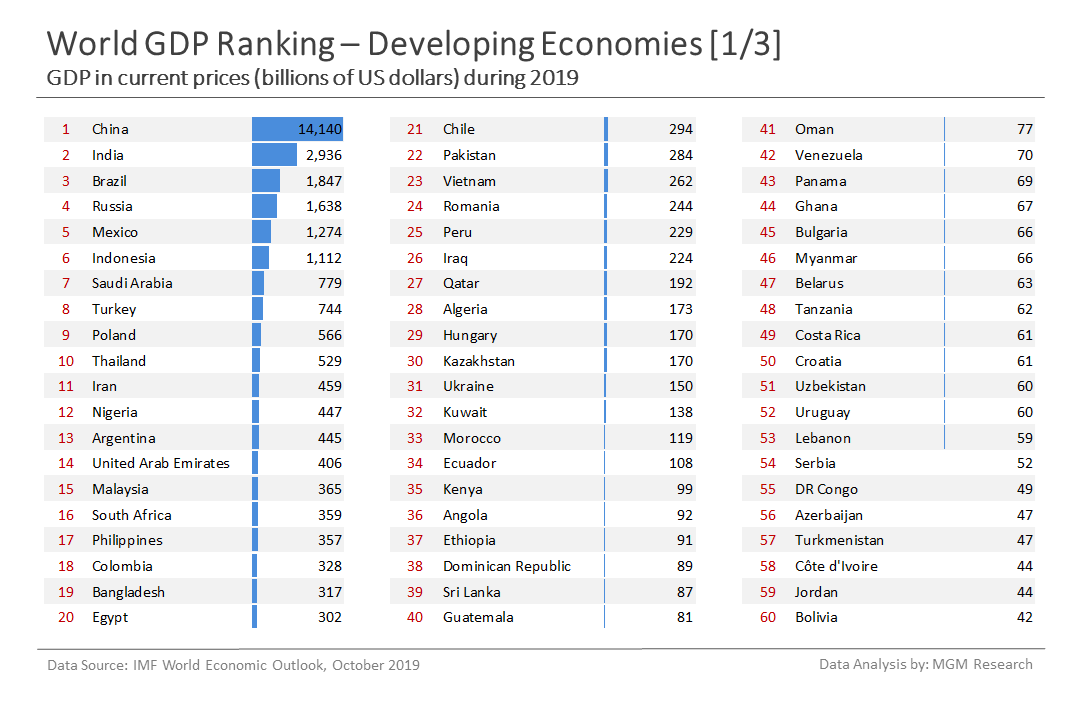
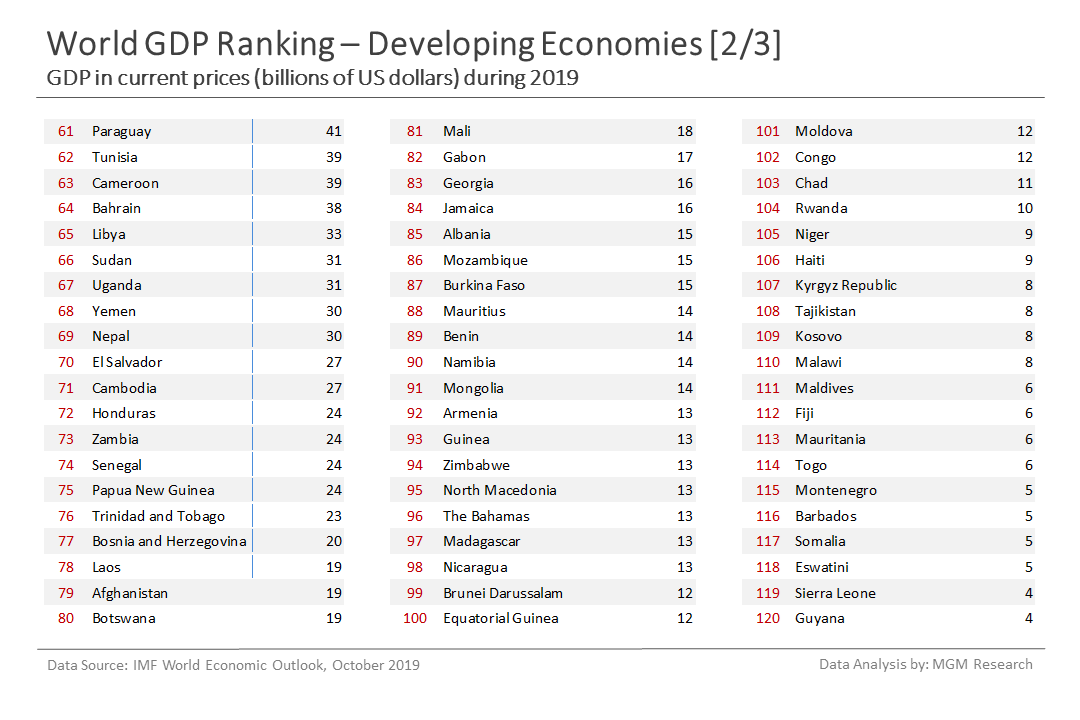
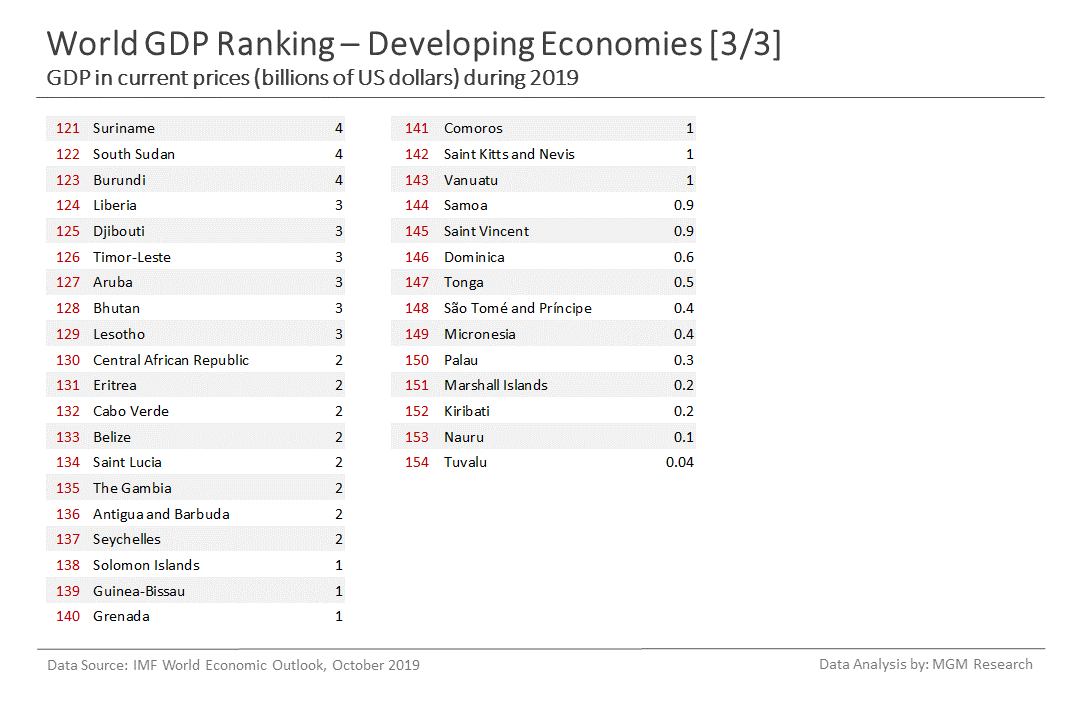
Notes
1. Data Source: International Monetary Fund (IMF) World Economic Outlook (WEO) database, October 2019 edition.
2. How does the WEO categorize advanced versus emerging market and developing economies? As per IMF, “The main criteria used by the WEO to classify the world into advanced economies and emerging market and developing economies are (1) per capita income level, (2) export diversification, and (3) degree of integration into the global financial system. Note, however, that these are not the only factors considered in deciding the classification of countries. This classification has evolved over time. The objective is to facilitate analysis by providing a reasonably meaningful method of organizing data. Reclassification only happens when something marked changes or the case for change in terms of the three criteria above becomes overwhelming.”